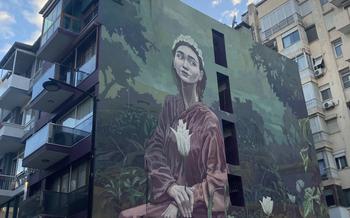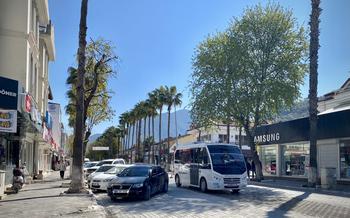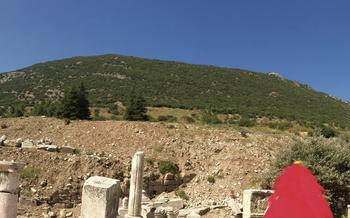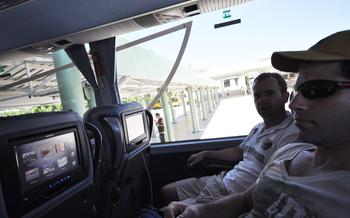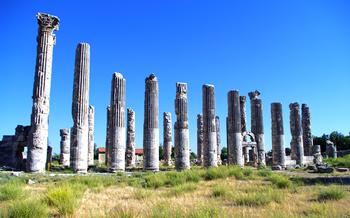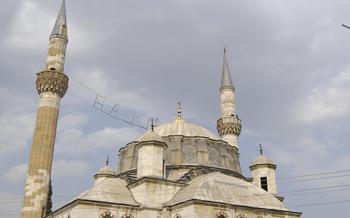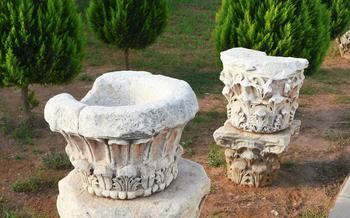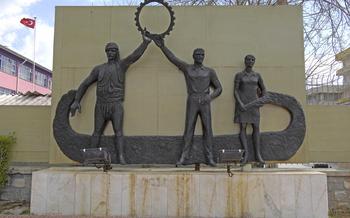
Latmos Ancient City
- Geographical Location:
- Preservation and Restoration
- Major Attractions
- Temple of Zeus
- Theater
- Agora: The Marketplace and Social Hub
- Necropolis: The City of the Dead
- Natural Surroundings:
- Local Cuisine
- Festivals and Events
- Accommodation
- Photography Tips
- Visitor Etiquette
- Insider Tip: Unveiling the Hidden Gem of Latmos
Geographical Location:
Latmos Ancient City is situated in the picturesque province of Aydın, in southwestern Turkey. Nestled between the foothills of the majestic Aydın Mountains and the shimmering waters of the Aegean Sea, Latmos offers a breathtaking backdrop of natural beauty. The ancient city is easily accessible from major cities like Izmir, approximately 120 kilometers to the north, and Antalya, around 300 kilometers to the east. Visitors can reach Latmos by car, following scenic roads that wind through charming villages and olive groves. Alternatively, regular bus services connect Aydın city center with nearby towns, making it convenient for travelers to explore the ancient ruins. For those seeking a more immersive experience, guided tours are available from local agencies, providing expert insights into the history and significance of Latmos.
Preservation and Restoration
Efforts to preserve and restore the ancient ruins of Latmos have been ongoing for decades. The Turkish government, in collaboration with archaeologists and international organizations, has undertaken numerous projects to protect the site from natural decay, vandalism, and urban development.
One of the primary challenges faced by conservationists is the ongoing threat of erosion and weathering. The ancient structures of Latmos, exposed to the elements for centuries, have suffered from the effects of wind, rain, and earthquakes. To address this, restoration teams have employed techniques such as stone reinforcement, grouting, and the use of protective coatings to stabilize and strengthen the ruins.
Another challenge lies in balancing the need for preservation with the desire to make the site accessible to visitors. While excavations and restoration projects have revealed valuable insights into Latmos' past, they have also raised concerns about the impact of increased tourism on the integrity of the ruins. To mitigate this, authorities have implemented measures such as controlled access, guided tours, and signage to ensure that visitors can explore the site responsibly while minimizing their impact on its preservation.
Ongoing projects at Latmos include the restoration of the theater, the excavation of the agora, and the development of a visitor center. These initiatives aim to enhance the visitor experience, provide better interpretation of the site's history, and promote sustainable tourism practices. By combining conservation efforts with responsible tourism, Latmos Ancient City can continue to share its rich cultural heritage with generations to come.
Major Attractions
Among the many captivating ruins and structures that await visitors at Latmos Ancient City, several key landmarks stand out for their architectural grandeur and historical significance. The Temple of Zeus, a testament to the city's religious devotion, boasts impressive columns, intricate carvings, and a rich history of worship and rituals. The theater, a center of cultural expression, echoes with the spirits of ancient performances, inviting visitors to imagine the vibrant plays, concerts, and gatherings that once filled the air. The agora, the bustling heart of Latmos, reveals the city's vibrant commercial and social life, with its well-preserved shops, stalls, and public buildings. And finally, the necropolis, a solemn reminder of the city's past, offers a glimpse into the funerary customs and beliefs of its ancient inhabitants through its diverse tombs, sarcophagi, and mausoleums. Each of these landmarks tells a unique story, transporting visitors back in time to experience the grandeur and everyday life of Latmos.
Temple of Zeus
The Temple of Zeus, dedicated to the supreme god of the Greek pantheon, stands as a testament to the religious devotion and architectural prowess of ancient Latmos. This magnificent structure, built in the 2nd century BC, reflects the Hellenistic influence that permeated the city during that era. Its imposing columns, intricately carved pediments, and lifelike sculptures evoke a sense of awe and reverence. Visitors can wander through the temple's ruins, admiring the exquisite craftsmanship and imagining the rituals and ceremonies that once took place within its sacred walls. Among the notable artifacts discovered during excavations is a colossal statue of Zeus, now housed in the Aydın Archaeological Museum, which provides a glimpse into the grandeur and artistry of the ancient city.
Theater
The theater in Latmos Ancient City, a magnificent structure carved into the hillside, holds a prominent place as a cultural and artistic hub. As an essential part of ancient Greek and Roman cities, the theater served as a venue for a diverse range of performances and events. Its well-preserved seating arrangements, intricate stage design, and remarkable acoustics offer a glimpse into the vibrant cultural life of Latmos.
Visitors can marvel at the theater's impressive layout, featuring tiers of stone seats that rise in a semicircle, providing excellent views of the stage. The stage itself, once adorned with intricate Bühnenbild and elaborate props, was the focal point of the theater's performances. The carefully designed acoustics ensured that every word and sound uttered on stage reached the audience with clarity, creating an immersive and engaging experience.
In ancient times, the theater hosted an array of performances, including plays, musical concerts, and public gatherings. Tragedies, comedies, and satires brought to life the stories of Greek mythology and contemporary life, captivating audiences with their dramatic narratives and thought-provoking themes. Musical concerts filled the air with enchanting melodies and rhythms, showcasing the talents of skilled musicians and vocalists. The theater also served as a platform for public speaking and debates, where citizens engaged in discussions on politics, philosophy, and social issues.
Efforts are underway to restore and preserve the theater, ensuring its continued existence for future generations. Through ongoing conservation projects, the theater's structural integrity is maintained, and its original features are carefully restored. The aim is to preserve the theater's historical significance while allowing visitors to experience the magic of ancient performances in an authentic setting.
Agora: The Marketplace and Social Hub
The agora, the central marketplace and social gathering place of ancient Latmos, bustled with activity during its heyday. This vibrant space served as the economic and social heart of the city, where locals and visitors alike converged to trade goods, exchange news, and engage in lively debates.
The agora's layout was designed to facilitate commerce and interaction. Rows of shops and stalls lined the perimeter, offering a diverse array of goods, from fresh produce and spices to handcrafted pottery and textiles. In the center of the agora stood an open area, where merchants displayed their wares and customers haggled over prices.
Beyond its commercial function, the agora served as a crucial social and political hub. Citizens gathered here to discuss matters of governance, listen to public announcements, and participate in political assemblies. The agora was also a place for entertainment and cultural exchange, where poets recited their verses, musicians performed, and philosophers engaged in lively debates.
Archaeological excavations have uncovered the remains of several significant structures within the agora, including a bouleuterion (council house), a stoa (covered walkway), and a temple dedicated to the goddess Artemis. These structures attest to the agora's multifaceted role in the daily life of ancient Latmos.
As you stroll through the agora's ruins, let your imagination transport you back in time to the bustling marketplace and vibrant social center it once was. Picture the merchants hawking their goods, the citizens debating the latest political issues, and the philosophers sharing their wisdom. The agora's legacy as a place of commerce, social interaction, and civic engagement continues to resonate, reminding us of the enduring importance of these spaces in ancient Greek and Roman cities.
Necropolis: The City of the Dead
Beneath the sun-baked earth of Latmos, a hidden world awaits exploration—the necropolis or cemetery. Here, among the ruins of ancient Latmos, lie the final resting places of its once-vibrant inhabitants. As you wander through this solemn city of the dead, you'll encounter a diverse array of tombs and burial chambers, each telling a silent tale of the lives and beliefs of those who came before.
Rock-cut tombs, carved into the soft limestone cliffs, offer a glimpse into the funerary practices of ancient Latmos. Elaborate facades, adorned with intricate carvings and inscriptions, hint at the status and wealth of the deceased. Step inside these subterranean chambers to discover a world of darkness and mystery, where echoes of ancient rituals still linger in the air.
Sarcophagi, or stone coffins, rest serenely among the ruins, their weathered surfaces bearing witness to the passage of time. These magnificent stone containers, often adorned with intricate reliefs and sculptures, served as the final resting place for some of Latmos' most prominent citizens. Gaze upon their stoic faces and let your imagination transport you back to a time when they walked among the living.
Mausoleums, grand and imposing structures, stand as testaments to the enduring legacy of Latmos' elite. These monumental tombs, built to honor the memory of the deceased, feature intricate architectural details, soaring columns, and elaborate carvings that rival those found in the city's temples. Enter these mausoleums and feel the weight of history pressing down upon you, as you stand in the presence of those who shaped the destiny of ancient Latmos.
As you explore the necropolis, take a moment to reflect on the lives and beliefs of those who once called Latmos home. Imagine the mourners gathered around these tombs, paying their final respects and entrusting their loved ones to the embrace of eternity. Let the whispers of the past guide you through this sacred space, where the boundaries between life and death blur, and the spirits of the ancients still reside.
Natural Surroundings:
Beyond the ancient ruins, Latmos Ancient City is surrounded by a stunning natural environment that offers a tranquil escape from the bustling city. The region is home to a diverse array of flora and fauna, with forests of pine, oak, and cypress trees providing a lush backdrop to the ancient ruins. Wildflowers bloom in abundance during the spring, adding vibrant colors to the landscape. Birdwatchers can delight in the diverse avian life, with species such as eagles, hawks, and woodpeckers soaring overhead.
For those seeking outdoor adventures, the area offers a network of hiking trails that wind through the forests and hills, leading to secluded spots and panoramic viewpoints. Visitors can embark on a leisurely stroll or challenge themselves with a more strenuous hike, taking in the breathtaking scenery along the way. Several picnic spots are scattered throughout the area, inviting visitors to relax and enjoy a meal surrounded by nature's beauty.
Remember to respect and preserve the natural environment while exploring the ancient city. Avoid littering, disturbing wildlife, or damaging plants. Embrace the opportunity to connect with nature and appreciate the harmonious coexistence of history and the environment at Latmos.
Local Cuisine
The Aydın region is renowned for its rich culinary traditions, blending Turkish, Greek, and Mediterranean flavors to create unique and delectable dishes. Visitors to Latmos Ancient City have the opportunity to savor the authentic tastes of the region at local restaurants or cafes.
Keşkek, a hearty dish made from wheat, meat, and spices, is a must-try for those seeking a traditional Turkish delicacy. Güveç, a clay pot dish featuring tender meat, vegetables, and aromatic spices, offers a tantalizing blend of flavors. And pide, a boat-shaped flatbread topped with various ingredients, is a popular street food that showcases the region's culinary artistry.
For those seeking a truly immersive culinary experience, attending local food festivals or culinary events is highly recommended. These events celebrate the region's rich gastronomy, showcasing traditional dishes, local produce, and the culinary skills of talented chefs. Visitors can indulge in delicious food, learn about local culinary traditions, and support the local economy by patronizing these events.
When dining in the Aydın region, visitors are encouraged to venture beyond the main tourist areas and explore local eateries that offer a more authentic experience. Supporting local businesses not only ensures a more memorable culinary journey but also contributes to the preservation of traditional recipes and culinary practices.
Festivals and Events
Latmos Ancient City and its surroundings come alive during various cultural festivals and events throughout the year. These celebrations offer visitors a unique opportunity to immerse themselves in the local traditions and customs of the region.
One of the most popular events is the Latmos Festival, held annually in July. This vibrant festival showcases traditional Turkish music, dance, and art, with performances by local and international artists. Visitors can enjoy live concerts, theater shows, and exhibitions, as well as sample delicious local cuisine and handicrafts.
Another highlight is the Endymion and Selene Festival, held in August. This festival celebrates the ancient myth of Endymion, a shepherd who was granted eternal sleep by the moon goddess Selene. Visitors can participate in reenactments of the myth, watch shadow plays and storytelling performances, and enjoy moonlit picnics under the stars.
For those interested in history and archaeology, the Latmos Symposium is a must-attend event. Held annually in September, this symposium brings together scholars, historians, and archaeologists from around the world to discuss the latest research and discoveries related to Latmos and the surrounding region. Participants can attend lectures, workshops, and guided tours, and engage in discussions with experts in the field.
These festivals and events offer visitors a chance to experience the rich cultural heritage of Latmos Ancient City and the Aydın region. Whether you're tertarik by music, dance, history, or mythology, there's something for everyone to enjoy. Be sure to check the dates and venues of these events in advance to plan your visit accordingly.
Accommodation
When planning your trip to Latmos Ancient City, a range of accommodation options await you, catering to diverse needs and budgets. For a budget-friendly stay, consider cozy guesthouses or hostels located within walking distance of the ancient ruins. These establishments offer basic amenities and a friendly atmosphere, allowing you to mingle with fellow travelers and share your experiences.
If you prefer a more comfortable stay, opt for mid-range hotels or boutique accommodations that offer modern amenities and convenient services. These hotels often feature traditional Turkish architecture and charming courtyards, immersing you in the local ambiance while providing a comfortable retreat after a day of exploration.
For an unforgettable experience, splurge on a stay at one of the luxury hotels or resorts in the region. These establishments offer opulent accommodations, world-class amenities, and breathtaking views of the ancient city and the surrounding natural landscapes. Indulge in rejuvenating spa treatments, savor gourmet cuisine at fine-dining restaurants, and bask in the exclusivity of these luxurious retreats.
No matter your budget or preferences, remember to book your accommodation in advance, particularly during the peak tourist season, to secure the best rates and availability. Embrace the local hospitality and immerse yourself in the rich cultural heritage of Aydın as you unwind and recharge for your adventures at Latmos Ancient City.
Photography Tips
Capturing the essence and beauty of Latmos Ancient City through photography is a rewarding experience for any traveler. Here are some tips to help you capture stunning photographs:
-
Golden Hour Magic: The best time to photograph Latmos is during the golden hours, just after sunrise or before sunset. The warm, diffused light during these times creates a magical glow, enhancing the textures and colors of the ancient ruins.
-
Strategic Viewpoints: Explore different viewpoints to find the most captivating angles. The hilltop overlooking the city offers panoramic views, while standing amidst the ruins provides a sense of intimacy and grandeur. Experiment with different perspectives to create unique compositions.
-
Architectural Details: Don't just focus on the big picture; take time to capture the intricate details of the ancient structures. Zoom in on columns, carvings, and inscriptions to reveal the craftsmanship and artistry of the past.
-
Natural Elements: Incorporate natural elements into your shots. Frame the ruins with trees, flowers, or the surrounding landscape to create a sense of depth and context. The play of light and shadow can also add drama and interest to your photographs.
-
Share Your Story: Share your Latmos photographs with the world! Use relevant hashtags and tag the location to connect with other travelers and photography enthusiasts. Your images might inspire others to explore this hidden gem and share their own unique perspectives.
Visitor Etiquette
As you explore Latmos Ancient City, it is crucial to remember that you are stepping into a place of historical and cultural significance. Show respect for the site and its surroundings by being mindful of your behavior and adhering to the following guidelines:
-
Dress Appropriately: Dress respectfully, avoiding revealing or overly casual attire that may be deemed inappropriate in a historical context.
-
Maintain Silence: Respect the tranquility of the site by keeping your voice low and avoiding loud conversations or noises that may disturb other visitors or disrupt the peaceful atmosphere.
-
Stay on Designated Paths: To protect the ancient ruins and their surroundings, stay on designated paths and avoid climbing on or damaging any structures.
-
Refrain from Touching Artifacts: Refrain from touching or handling any artifacts or ruins, as this can cause damage or wear over time.
-
Dispose of Waste Properly: Please dispose of any waste responsibly in designated bins to maintain the cleanliness and beauty of the site.
-
Respect Local Customs: Be respectful of local customs and traditions, especially when interacting with local people or visiting religious or sacred areas.
By following these simple guidelines, you can contribute to preserving the integrity of Latmos Ancient City and ensure a respectful and enjoyable experience for all visitors.
Insider Tip: Unveiling the Hidden Gem of Latmos
Beyond the main attractions of Latmos Ancient City, there lies a hidden gem waiting to be discovered by curious travelers. Nestled amidst the ruins, a secluded spot offers a breathtaking panorama of the ancient city and the surrounding landscape. As the sun dips below the horizon, the sky transforms into a canvas of vibrant hues, casting a magical glow upon the ancient ruins.
For those seeking a unique and immersive experience, venture off the beaten path and find this secret viewpoint. Spread out a blanket, savor a picnic with local delicacies, and let the tranquility of the moment transport you back in time. As darkness envelops the ancient city, the stars emerge, painting a celestial tapestry above the ruins.
This hidden gem is not just a place to admire the beauty of Latmos but also a place to connect with its history and mystery. Let the whispers of the past guide you as you explore the ancient ruins, uncovering the secrets that lie beneath the surface. Embrace the spirit of adventure and discover the hidden treasures of Latmos, creating memories that will last a lifetime.

